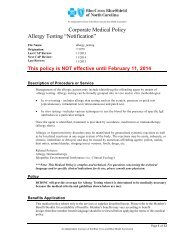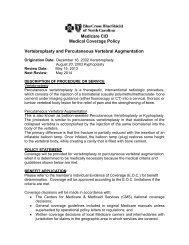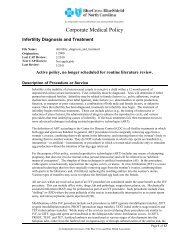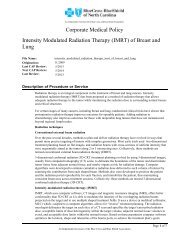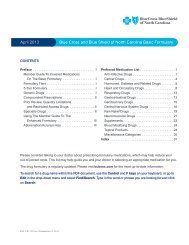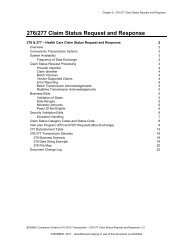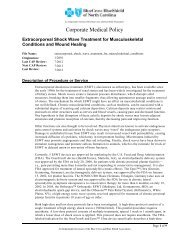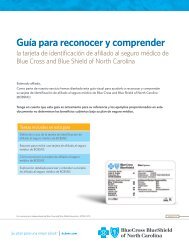Surgical Treatment of Chest Wall Deformities - Blue Cross and Blue ...
Surgical Treatment of Chest Wall Deformities - Blue Cross and Blue ...
Surgical Treatment of Chest Wall Deformities - Blue Cross and Blue ...
You also want an ePaper? Increase the reach of your titles
YUMPU automatically turns print PDFs into web optimized ePapers that Google loves.
Corporate Medical Policy<br />
<strong>Surgical</strong> <strong>Treatment</strong> <strong>of</strong> <strong>Chest</strong> <strong>Wall</strong> <strong>Deformities</strong> (Congenital or<br />
Acquired)<br />
File Name: surgical_treatment_<strong>of</strong>_chest_wall_deformities_congenital_or_acquired<br />
Origination:<br />
Last CAP Review:<br />
Next CAP Review:<br />
Last Review:<br />
1/2009<br />
9/2012<br />
9/2013<br />
9/2012<br />
Description <strong>of</strong> Procedure or Service<br />
<strong>Chest</strong> wall deformities are usually congenital but may be acquired due to trauma. There are 3 types<br />
<strong>of</strong> congenital chest wall deformities; pectus excavatum, pectus carinatum, <strong>and</strong> Pol<strong>and</strong>’s syndrome.<br />
<strong>Chest</strong> wall abnormalities can cause cardiopulmonary problems due to physiologic impairment.<br />
Symptoms frequently do not appear during childhood because <strong>of</strong> the pliability <strong>of</strong> the chest. As the<br />
child grows, the chest becomes more rigid causing the patient to develop symptoms.<br />
Pectus excavatum (PE) is the most common congenital chest wall deformity <strong>and</strong> is found<br />
predominantly in males. Pectus excavatum is also known as cobbler’s chest, sunken chest,<br />
hallowed breast, or funnel breast. This condition is thought to occur due to an excessive growth <strong>of</strong><br />
the lower costal cartilages, which causes a concave appearance <strong>of</strong> the chest. The lower third part <strong>of</strong><br />
the inwardly displaced sternum is usually most affected. PE is usually diagnosed within the first<br />
year <strong>of</strong> life <strong>and</strong> tends to worsen as the child grows. It typically worsens during puberty, which is a<br />
time <strong>of</strong> rapid growth. The deformity may be deeper on the right side than the left possibly due to a<br />
rotation <strong>of</strong> the sternum. This can cause various degrees <strong>of</strong> sternal depression. Sternal depression<br />
may cause dyspnea, chest pain, palpitations <strong>and</strong> fatigue with mild physical activity. Other<br />
symptoms <strong>of</strong> PE are frequent respiratory infections, asthmatic symptoms <strong>and</strong> functional impairment<br />
due to respiratory impairment. PE is frequently associated with scloliosis, Marfan syndrome, <strong>and</strong><br />
congenital heart disease.<br />
Pectus carinatum (PC) is not as common as pectus excavatum but like PE is most frequently seen in<br />
males. Pectus carinatum is also known as pigeon breast, chicken breast <strong>and</strong> keeled chest. PC<br />
appears as a flattened chest with a bowed out appearance. This condition is not usually diagnosed<br />
until the rapid growth that occurs during puberty. Patients with pectus carinatum may have<br />
symptoms such as restrictive air exchange. Depending on the degree <strong>of</strong> the defect they may have<br />
difficulty with expiration <strong>of</strong> air out <strong>of</strong> the lungs. Conditions associated with PC are respiratory<br />
infections, rickets, asthma, <strong>and</strong> cardiac abnormalities.<br />
Pol<strong>and</strong> syndrome is a rare birth defect <strong>and</strong> appears with lateral depression <strong>of</strong> the ribs usually on the<br />
right side more <strong>of</strong>ten than the left side. Pol<strong>and</strong> syndrome is also known as Pol<strong>and</strong>’s anomaly or<br />
Pol<strong>and</strong>’s syndactyly. It, like PE <strong>and</strong> PC, is seen most frequently in males. When the defect occurs<br />
on the left side <strong>of</strong> the sternum the heart <strong>and</strong> lungs are more affected because they are covered only<br />
by a thin layer <strong>of</strong> skin <strong>and</strong> tissue. Pol<strong>and</strong> syndrome appears with absences or incomplete<br />
development <strong>of</strong> the pectoralis minor muscles <strong>and</strong> <strong>of</strong> the costal cartilages. Hypoplasia <strong>of</strong> the breast,<br />
subcutaneous tissue, lack <strong>of</strong> axillary hair <strong>and</strong> h<strong>and</strong> <strong>and</strong> upper extremity defects are also signs.<br />
Portions <strong>of</strong> the second, third <strong>and</strong> fourth ribs may be partially absent as well as upper costal<br />
cartilage.<br />
An Independent Licensee <strong>of</strong> the <strong>Blue</strong> <strong>Cross</strong> <strong>and</strong> <strong>Blue</strong> Shield Association<br />
Page 1 <strong>of</strong> 5
<strong>Surgical</strong> <strong>Treatment</strong> <strong>of</strong> <strong>Chest</strong> <strong>Wall</strong> <strong>Deformities</strong> (Congenital or<br />
Acquired)<br />
Policy<br />
***Note: This Medical Policy is complex <strong>and</strong> technical. For questions concerning the technical<br />
language <strong>and</strong>/or specific clinical indications for its use, please consult your physician.<br />
BCBSNC will provide coverage for surgical treatment <strong>of</strong> chest wall deformities (congenital or<br />
acquired) when it is determined to be medically necessary <strong>and</strong> when the medical criteria <strong>and</strong><br />
guidelines shown below are met.<br />
Benefits Application<br />
This medical policy relates only to the services or supplies described herein. Please refer to the Member's<br />
Benefit Booklet for availability <strong>of</strong> benefits. Member's benefits may vary according to benefit design;<br />
therefore member benefit language should be reviewed before applying the terms <strong>of</strong> this medical policy.<br />
Most BCBSNC benefit plans limit coverage for cosmetic procedures, while providing coverage for<br />
reconstructive procedures. These terms are defined as follows:<br />
a. Cosmetic-to improve appearance. This does not include restoration <strong>of</strong> physiological function<br />
resulting from accidental injury, trauma or previous treatment that would be considered a<br />
covered service. This also does not include reconstructive surgery to correct congenital or<br />
developmental anomalies that have resulted in functional impairment<br />
b. Reconstructive procedures are performed on structures <strong>of</strong> the body for the purpose <strong>of</strong><br />
improving/restoring bodily function or correcting significant deformity resulting from accidental<br />
injury, trauma, or previous therapeutic process.<br />
Please refer to Certificate for availability <strong>of</strong> benefits. This policy relates only to the services or supplies<br />
described herein. Benefits may vary according to benefit design; therefore certificate language should be<br />
reviewed before applying the terms <strong>of</strong> the policy.<br />
When <strong>Surgical</strong> <strong>Treatment</strong> <strong>of</strong> <strong>Chest</strong> <strong>Wall</strong> <strong>Deformities</strong> (Congenital or Acquired) is<br />
covered<br />
<strong>Surgical</strong> <strong>Treatment</strong> <strong>of</strong> Pectus Excavatum, Pectus Carinatum, or Pol<strong>and</strong> syndrome may be medically<br />
necessary <strong>and</strong> reconstructive when the following guidelines are met:<br />
1. When there is functional impairment, documented by one <strong>of</strong> the following:<br />
• decreased cardiac output <strong>and</strong>/or abnormal pulmonary function during exercise; OR<br />
• anticipation <strong>of</strong> future cardiovascular compromise; OR<br />
• signs or symptoms that impair the patient’s ability to participate in usual activities, such<br />
as shortness <strong>of</strong> breath (dyspnea) at rest or on exertion; OR<br />
• arrythmias or clinical stigmata <strong>of</strong> decreased cardiac output; AND<br />
2. The procedure is expected to correct the functional impairment; AND<br />
An Independent Licensee <strong>of</strong> the <strong>Blue</strong> <strong>Cross</strong> <strong>and</strong> <strong>Blue</strong> Shield Association<br />
Page 2 <strong>of</strong> 5
<strong>Surgical</strong> <strong>Treatment</strong> <strong>of</strong> <strong>Chest</strong> <strong>Wall</strong> <strong>Deformities</strong> (Congenital or<br />
Acquired)<br />
3. The anatomical criterion for the condition is met:<br />
a. for treatment <strong>of</strong> Pectus Excavatum, the Haller Index is greater than or equal to 3.2, OR<br />
b. for treatment <strong>of</strong> Pectus Carinatum, the Haller Index is less than or equal to 2.0, OR<br />
c. for treatment <strong>of</strong> Pol<strong>and</strong> syndrome, when rib formation is absent.<br />
When <strong>Surgical</strong> <strong>Treatment</strong> <strong>of</strong> <strong>Chest</strong> <strong>Wall</strong> <strong>Deformities</strong> (Congenital or Acquired) is<br />
not covered<br />
A. When the guidelines above are not met; OR<br />
B. When the surgical treatment is for cosmetic reasons (intended to improve appearance <strong>and</strong> not primarily<br />
to restore bodily function or to correct significant deformity resulting from accidental injury, trauma, or<br />
previous therapeutic process.)<br />
Policy Guidelines<br />
The Haller index, or pectus severity index, is the most common used scale for determining the<br />
severity <strong>of</strong> chest wall deformities. The Haller index is obtained by dividing the inner width <strong>of</strong> the<br />
chest at its widest point by the distance between the posterior surface <strong>of</strong> the sternum <strong>and</strong> the<br />
anterior surface <strong>of</strong> the spine. This measurement uses the deepest level <strong>of</strong> the inner sternal<br />
depression to the anterior aspect <strong>of</strong> the vertebral body. CT scans are used to define the index. At<br />
times the rotation, asymmetry <strong>and</strong> underlying chest structure may make this measurement difficult<br />
to obtain. A normal chest has a Haller index <strong>of</strong> about 2.5.<br />
Billing/Coding/Physician Documentation Information<br />
This policy may apply to the following codes. Inclusion <strong>of</strong> a code in this section does not guarantee that it<br />
will be reimbursed. For further information on reimbursement guidelines, please see Administrative<br />
Policies on the <strong>Blue</strong> <strong>Cross</strong> <strong>Blue</strong> Shield <strong>of</strong> North Carolina web site at www.bcbsnc.com. They are listed in<br />
the Category Search on the Medical Policy search page.<br />
Applicable service codes: 21740, 21742, 21743<br />
BCBSNC may request medical records for determination <strong>of</strong> medical necessity. When medical records are<br />
requested, letters <strong>of</strong> support <strong>and</strong>/or explanation are <strong>of</strong>ten useful, but are not sufficient documentation unless all<br />
specific information needed to make a medical necessity determination is included.<br />
Scientific Background <strong>and</strong> Reference Sources<br />
Cheezum MK, Lettieri CJ. Cardiopulmonary manifestations <strong>of</strong> pectus excavatum. Retrieved<br />
10/31/08 from http://bcbsma.medscape.com/viewarticle/571222_print.<br />
Senior Medical Director Review - 1/22/2009<br />
Specialty Matched Consultant Advisory Panel review 9/2010<br />
Jaroszewski D, Notrica D, McMahon L, Steidley DE, Deschamps C. Current management <strong>of</strong> pectus<br />
An Independent Licensee <strong>of</strong> the <strong>Blue</strong> <strong>Cross</strong> <strong>and</strong> <strong>Blue</strong> Shield Association<br />
Page 3 <strong>of</strong> 5
<strong>Surgical</strong> <strong>Treatment</strong> <strong>of</strong> <strong>Chest</strong> <strong>Wall</strong> <strong>Deformities</strong> (Congenital or<br />
Acquired)<br />
excavatum: a review <strong>and</strong> update <strong>of</strong> therapy <strong>and</strong> treatment recommendations. J Am Board Fam Med.<br />
2010 Mar-Apr;23(2):230-9. Retrieved on August 17, 2010 from<br />
http://www.jabfm.org/cgi/content/full/23/2/230<br />
Specialty Matched Consultant Advisory Panel review 9/2011<br />
Brochhausen C, Turial S, Müller FK, Schmitt VH, Coerdt W, Wihlm JM, Schier F, Kirkpatrick CJ.<br />
Pectus excavatum: history, hypotheses <strong>and</strong> treatment options. Interact Cardiovasc Thorac Surg.<br />
2012 Jun;14(6):801-6. Retrieved from http://icvts.oxfordjournals.org/content/14/6/801.long<br />
Blanco FC, Elliott ST, S<strong>and</strong>ler AD. Management <strong>of</strong> congenital chest wall deformities. Semin Plast<br />
Surg. 2011 Feb;25(1):107-16. Retrieved from<br />
http://www.ncbi.nlm.nih.gov/pmc/articles/PMC3140238/?tool=pubmed<br />
Medical Director review 8/2012<br />
Specialty Matched Consultant Advisory Panel review 9/2012<br />
Policy Implementation/Update Information<br />
2/16/09 New policy written. Reviewed with Senior Medical Director 1/22/2009. <strong>Surgical</strong> treatment<br />
<strong>of</strong> chest wall deformites (congenital or acquired) may be medically necessary <strong>and</strong> reconstructive<br />
when the following guidelines are met: A.<strong>Surgical</strong> treatment for Pectus Excavatum: 1. when there<br />
is documented functional impairment (i.e., decreased cardiac output <strong>and</strong>/or abnormal pulmonary<br />
function during exercise; OR 2. when future cardiovascular compromise is anticipated; OR 3.<br />
when there is medical record documentation <strong>of</strong> signs or symptoms that impair the patient’s ability<br />
to participate in usual activities, such as shortness <strong>of</strong> breath (dyspnea) at rest or on exertion; OR 4.<br />
when there are arrythmias or clinical stigmata <strong>of</strong> decreased cardiac output; AND 5. the Haller<br />
Index is greater than or equal to 3.2. AND 6. the procedure is expected to correct the functional<br />
impairment. B. <strong>Surgical</strong> treatment for Pectus Carinatum: 1.when there is documented functional<br />
impairment (i.e., decreased cardiac output <strong>and</strong>/or abnormal pulmonary function during exercise;<br />
OR 2. when future cardiovascular compromise is anticipated; OR 3. when there is medical record<br />
documentation <strong>of</strong> signs or symptoms that impair the patient’s ability to participate in usual<br />
activities, such as shortness <strong>of</strong> breath (dyspnea) at rest or on exertion; OR 4. when there are<br />
arrhythmias or clinical stigmata <strong>of</strong> decreased cardiac output; AND 5. the Haller Index is less than or<br />
equal to 2.0; AND 6. the procedure is expected to correct the functional impairment. C. <strong>Surgical</strong><br />
treatment for Pol<strong>and</strong> syndrome: 1. when there is documented functional impairment (i.e., decreased<br />
cardiac output <strong>and</strong>/or abnormal pulmonary function during exercise; OR 2. when future<br />
cardiovascular compromise is anticipated; OR 3. when there is medical record documentation <strong>of</strong><br />
signs or symptoms that impair the patient’s ability to participate in usual activities, such as<br />
shortness <strong>of</strong> breath (dyspnea) at rest or on exertion; OR 4. when there are arrythmias or clinical<br />
stigmata <strong>of</strong> decreased cardiac output; AND 5. when rib formation is absent; AND 6. the procedure<br />
is expected to correct the functional impairment. "When Not Covered": A. When the guidelines<br />
above are not met; OR B. When the surgical treatment is for cosmetic reasons (intended to improve<br />
appearance <strong>and</strong> not primarily to restore bodily function or to correct significant deformity resulting<br />
from accidental injury, trauma, or previous therapeutic process.)" Notification given 2/16/09.<br />
Policy effective 5/18/09. (btw)<br />
6/22/10 Policy Number(s) removed (amw)<br />
10/26/10 Specialty Matched Consultant Advisory Panel review 9/2010. Combined criteria numbers<br />
An Independent Licensee <strong>of</strong> the <strong>Blue</strong> <strong>Cross</strong> <strong>and</strong> <strong>Blue</strong> Shield Association<br />
Page 4 <strong>of</strong> 5
<strong>Surgical</strong> <strong>Treatment</strong> <strong>of</strong> <strong>Chest</strong> <strong>Wall</strong> <strong>Deformities</strong> (Congenital or<br />
Acquired)<br />
4 through 6 under the “When covered” section for Pectus Excavatum , Pectus Carinatum <strong>and</strong> Pol<strong>and</strong><br />
syndrome. References updated. (mco)<br />
10/11/11 Removed information regarding the Haller Index from “Description” section,as it is also<br />
discussed in the “Policy Guidelines” section. Consolidated the “When Covered” section. Added the<br />
following requirements to the “When Covered” section: a. for treatment <strong>of</strong> Pectus Excavatum, the<br />
Haller Index is greater than or equal to 3.2, OR b. for treatment <strong>of</strong> Pectus Carinatum, the Haller Index is<br />
less than or equal to 2.0, OR c. for treatment <strong>of</strong> Pol<strong>and</strong> syndrome, when rib formation is absent.<br />
Specialty Matched Consultant Advisory Panel review 9/2011. (mco)<br />
10/16/12 References updated. Medical Director review 8/2012. Specialty Matched Consultant<br />
Advisory Panel review 9/2012. No changes to Policy Statements. (mco)<br />
Medical policy is not an authorization, certification, explanation <strong>of</strong> benefits or a contract. Benefits <strong>and</strong> eligibility are determined<br />
before medical guidelines <strong>and</strong> payment guidelines are applied. Benefits are determined by the group contract <strong>and</strong> subscriber<br />
certificate that is in effect at the time services are rendered. This document is solely provided for informational purposes only <strong>and</strong><br />
is based on research <strong>of</strong> current medical literature <strong>and</strong> review <strong>of</strong> common medical practices in the treatment <strong>and</strong> diagnosis <strong>of</strong><br />
disease. Medical practices <strong>and</strong> knowledge are constantly changing <strong>and</strong> BCBSNC reserves the right to review <strong>and</strong> revise its<br />
medical policies periodically.<br />
An Independent Licensee <strong>of</strong> the <strong>Blue</strong> <strong>Cross</strong> <strong>and</strong> <strong>Blue</strong> Shield Association<br />
Page 5 <strong>of</strong> 5



